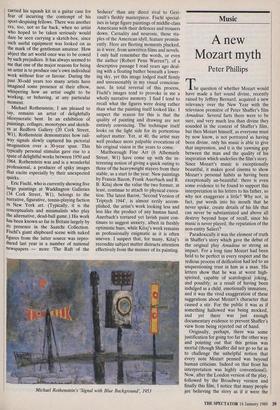Exhibitions 2
Michael Rothenstein: Signals (Redfern Gallery, till 8 February) Eric Fischl
(Waddington Galleries, till 28 January)
Auerbach, Bacon, Kitaj (Marlborough Fine Art, till 10 February)
Deep-water shoal
Giles Auty
The first exhibitions of the new year coincide roughly with the start of the Lent term in schools. At a party for the Amer- ican painter Eric Fischl at Waddington's last week most of those present seemed full of a good humour that was almost school- boyish in nature, as though we were greeting each other once more simply to swap tales of the Christmas hols. The art world is not always so good-tempered and I was gratified especially when a leading figure, whom I have characterised in these pages previously as a particularly hard-line modernist, told me how much he had agreed with my Christmas article on the need for some traditionally based alterna- tive in art school education. Apparently he had advocated the same thing himself. Are we all growing up at last, in a new era of pluralist goodwill?
In the world of New York art, so Mr Fischl assures me, the fiercest division today is between artists who play golf and those who prefer tennis. How different all this is from a generation ago when a young art student I was friendly with habitually carried his squash kit in a guitar case for fear of incurring the contempt of his sport-despising fellows. There was another era, too, not so far back, when no artist who hoped to be taken seriously would dare be seen carrying a sketch-box, since such useful equipment was looked on as the mark of the gentleman amateur. How abject the art world once was to be cowed by such prejudices. It has always seemed to me that one of the major reasons for being an artist is to produce one's own individual work without fear or favour. During the past 30-odd years too many artists have Imagined some presence at their elbow, whispering how an artist ought to be working, or behaving, at any particular moment.
Michael Rothenstein, I am pleased to say, remains an artist of delightfully idiosyncratic bent. In an exhibition of paintings, collages, monotypes and sketch- es at Redfern Gallery (20 Cork Street, W1), Rothenstein demonstrates how rail- way signals slowly captured his pictorial Imagination over a 30-year span. This typically personal stimulus gave rise to a spate of delightful works between 1950 and 1964. Rothenstein was and is a wonderful professional, a producer of spiky images that excite especially by their unexpected quirks.
Eric Fischl, who is currently showing five large paintings at Waddington Galleries (34 Cork Street, W1), belongs to the narrative, figurative, tennis-playing faction in New York art. (Typically, it is the conceptualists and minimalists who play the alternative, dead-ball game.) His work has been known so far in Britain largely by its presence in the Saatchi Collection. Fischl's giant shipboard scene with naked figures from the latter source was repro- duced last year in a number of national newspapers — more 'The Raft of the Seducer' than any direct rival to Geri- cault's fleshly masterpiece. Fischl special- ises in large figure paintings of middle-class Americans with their defences and trousers down. Carnality and neurosis, those sta- ples of the American idyll, feature promin- ently. Here are fleeting moments plucked, as it were, from unwritten films and novels. I only half remember the words, or even the author (Robert Penn Warren?), of a descriptive passage I read years ago deal- ing with a floating bather beneath a lower- ing sky, yet this image lodged itself firmly and unreasonably in my visual conscious- ness. In total reversal of this process, Fischl's images tend to provoke in me a wholly narrative memory. I find I tend to recall what the figures were doing rather than what the painting itself looked like. I suspect the reason for this is that the quality of painting and drawing are not entirely convincing. The technique itself looks on the light side for its portentous subject matter. Yet, at 40, the artist may well produce more palpable evocations of his original vision in the years to come.
Marlborough Fine Art (6 Albemarle Street, W1) have come up with the in- teresting notion of giving a quick outing to three of the heavyweight stayers from their stable, as a start to the year. New paintings by Francis Bacon, Frank Auerbach and R. B. Kitaj show the value the two former, at least, continue to attach to physical execu- tion. The latest Bacon, 'Second Version of Triptych 1944', is almost eerily accom- plished, the artist's work looking less and less like the product of any human hand. Auerbach's tortured yet lavish paint con- tinues to suggest anxiety, albeit in freshly optimistic hues, while Kitaj's work remains as professionally enigmatic as it is often uneven. I suspect that, for many, Kitaj's recondite subject matter distracts attention effectively from the manner of its painting.
Michael Rothenstein's 'Signal with Blue Background', 1953



















































 Previous page
Previous page